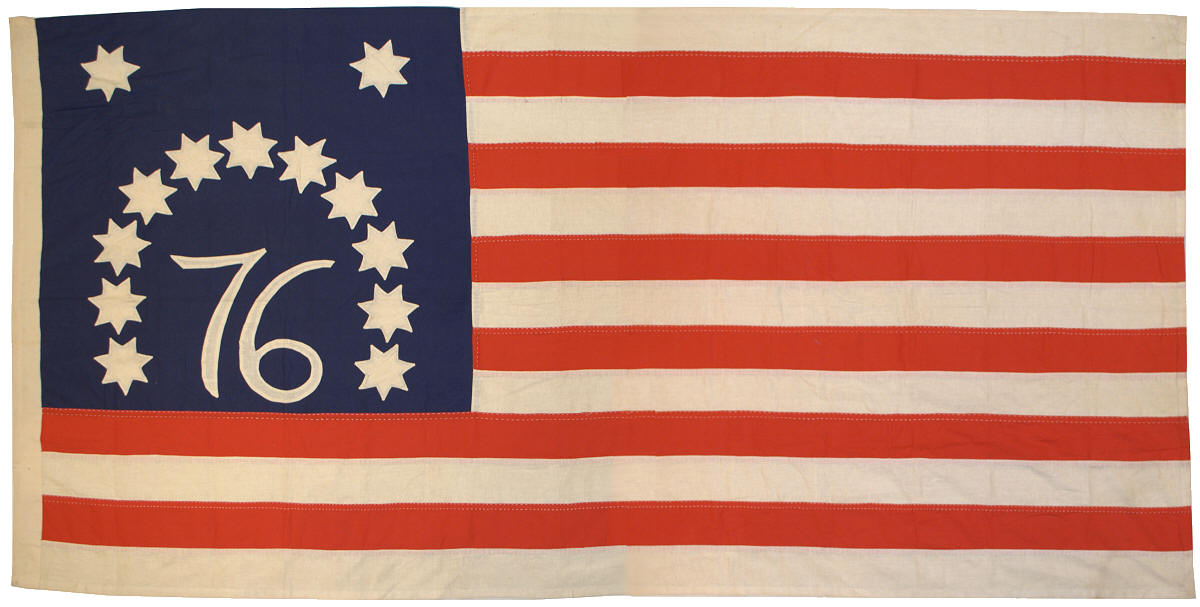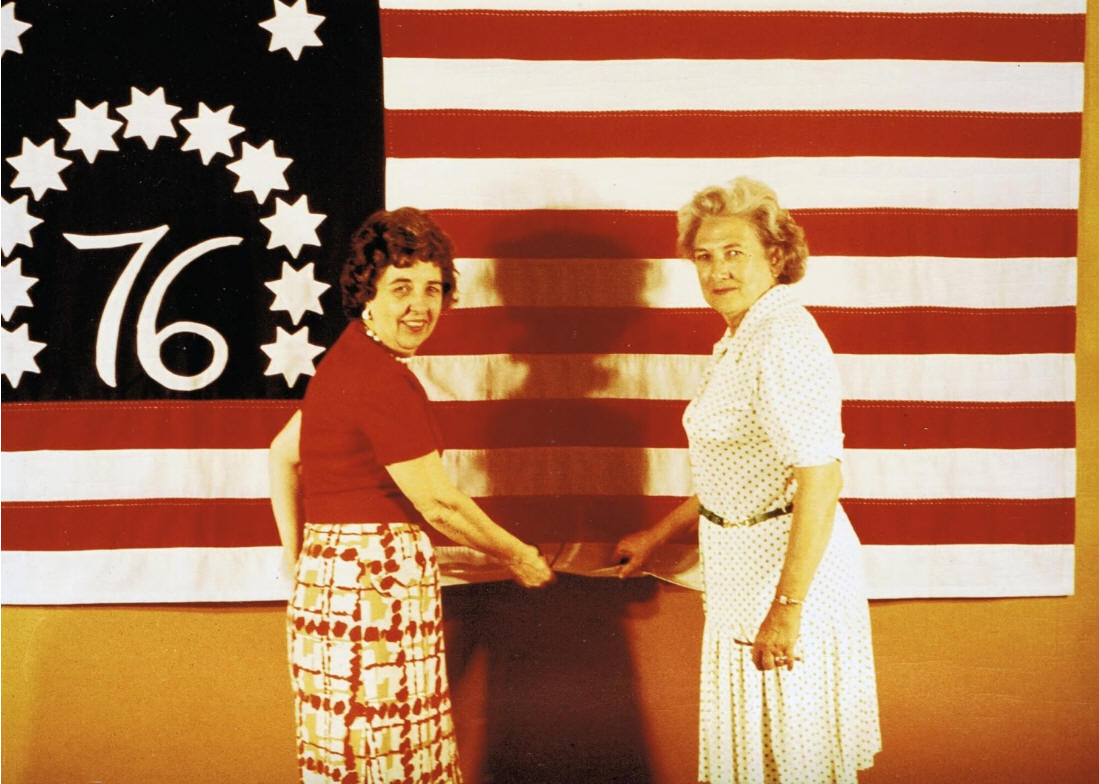|

One of the most famous
early American flags is the Bennington Flag, which is
currently located at the Bennington Museum in
Bennington, Vermont. According to the history of
the flag as posted on the Bennington Museum website:
| |
"Acknowledged as the oldest Stars and Stripes,
this unusually large
flag was said to have flown over General
Stark's encampment during the Battle of
Bennington. Long thought to have been flown at
the Battle of Bennington, this
flag was in fact created after 1800. A
solid family history in the Fillmore family,
related to 13th President of the United States
Millard Fillmore, dates the
flag to the era of the War of 1812. Fiber
analysis performed in 1995 concluded that the
flag was constructed of machine-spun
cotton, a process that was not possible until
1800 and realistically until 1810. The "76" on
this
flag was most likely used to commemorate
the victory of the American Revolution during
the hard years of the War of 1812. The
flag presents a unique interpretation of
the Stars and Stripes; the
flag is related in concept and design to
other historical regimental
flags where emphasis was placed on the
field and arrangement of the stars. The striking
"arch" form as well as the unique seven pointed
stars may have Masonic significance. The stripes
follow the heraldic order frequently used during
the Revolutionary period, alternating white and
red, instead of the red and white of more recent
American
flags." - The Bennington Museum |
|
There has also been
speculation that the flag dates to as late as the
American Centennial in 1876, but regardless of the age
of the original flag, its pattern and design has become
iconic in American culture. The American Bicentennial of
1976 saw the Bennington Flag emerge as a tremendously
popular choice for Americans wanting to display a
patriotic representation of an early American flag.
This example in the Rare Flags collection is extremely
special and scarce. Whereas most examples from the
American Bicentennial were mass produced and
manufactured, this flag is homemade and entirely hand
sewn. At nearly 8 feet long, it is a masterpiece
of workmanship. The stars of the flag, which are
large and bold on the canton, are single-appliqué,
meaning that the maker cut the shape of the stars
through the canton and then used a single piece of white
fabric for the star itself. This method of
creating the stars on our flags was prevalent in the
early 19th century, but by the 20th century it had
become a lost art. To see this construction on a
flag made toward the end of the 20th century is
remarkable. The sleeve hoist shows evidence that the
flag was flown, though its excellent condition indicates
that it was only used briefly, perhaps just at the
time of the Bicentennial Celebration. The stylized "76", which is also of
single-appliqué workmanship, has a charming, folky
1970's era flare to its font. The seamstress used blue
thread when stitching the stars and 76 on the canton to
hide the stitches against the blue background.
True to the style of the original Bennington Flag, the
stars of the flag are seven-pointed, the flag starts and
ends on white stripes rather than red, the canton
extends through nine vertical stripes, and sits on a red
stripe. The flag has a companion, a beautiful
Continental Colors,
IAS-00332, which was made at the
same time and likely by the same hand. Of the
thousands of late 20th century and 21st century examples
of the Bennington flag which are continually offered for
sale in the marketplace, this is the only
pieced-and-sewn homemade example of the type that I've
ever encountered. It is a modern masterpiece of
American flag-making and a treasure of the Rare Flags
collection.
After acquiring this
flag along with IAS-00332 in 2012, a flag collector sent
a note in 2019 regarding a 2017 obituary in the
Washington Post for artist Virginia W. Ames, who passed
away on March 3, 2017 at the age of 102 years old.
| |
"Virginia W. Ames, a founding member of the
Torpedo Factory Art Center in Alexandria, Va.,
and creator of an oversize set of Revolutionary
War-era flags for display at the Library of
Congress during the Bicentennial, died March 3
at her home in Tucson. She was 102. In 1974, she
was commissioned by the Library of Congress to
prepare a Bicentennial exhibition of
Revolutionary War flags and for the next two
years
researched and then hand-sewed 12 flags under
which American units fought against the British.
Most were militia flags: the Rhode Island
regimental flag, a Bunker Hill flag, the flag of
the 3rd New York regiment and the “Don’t Tread
on Me” flag with a representation of a serpent." - The
Washington Post, April 12, 2017 |
|
Pictured in the
Washington Post article is a photo if Mrs. Ames with
this Bennington Flag, providing clear attribution of the
flag's history as one of the twelve commissioned for the
Library of Congress Bicentennial Exhibition.

Virginia
Ames, right, and Kathryn Sanborn, wife of Library of
Congress exhibits director Herbert J. Sanborn, display
Mrs. Ames's reproduction of the Bennington Flag, one of
a dozen commissioned for the Bicentennial exhibition.
(Herbert J. Sanborn) |

